Posts
-
Let's Read the 4e Monster Manual 3: Skulk
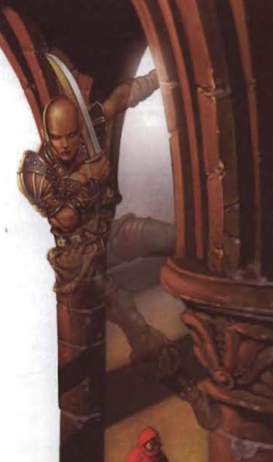
Copyright 2010 Wizards of the Coast. This post is part of a series! Click here to see the others.
Skulks first appeared on the AD&D Fiend Folio. This is their 4e debut, with all-new lore.
The Lore
Centuries ago, the human empire of Bael Turath fought a dreadful war against the dragonborn empire of Arkhosia. Bael Turath was never a nice place: its society was severely stratified, and its ruling nobles were slavers that spared little thought to those they enslaved. When it found itself losing the war against Arkhosia, those same ruling nobles did not hesitate to turn to Hell for help, and forged the diabolic pact that would see them and their descendants transformed into tieflings. We’ve seen all of this before, and we also know that the pact didn’t help them in the end. Bael Turath fell just the same, with the pact’s boon at most allowing them to take Arkhosia with them.
In this entry we see one of the reasons why it fell. The pact for infernal power excluded Bael Turath’s large enslaved population, even as it lowered the slavers’ guard. There was a huge rebellion where many of Bael Turath’s noble caste were murdered in their sleep. Some of the rebels did this to escape their bonds, but some did it because they were angry at being excluded from the infernal pact. The Demon Prince Graz’zt was impressed with the latter and reached out to them to offer his patronage. Those who accepted became the creatures known as skulks.
Skulks are sapient humanoids with a supernatural affinity for stealth. Ironically enough, they are much more indebted to their demon patron than modern-day tieflings are to whatever devil mutated their ancestors. This eternal debt is encoded in a document known as the Book of the Blinded Eye, and it bids even present-day skulks to follow the orders of Graz’zt’s servants. They’re often sent out as assassins to eliminate threats to the cult or their demon master.
The skulks’ hatred of tieflings is equally eternal, and probably also enforced by the demonic pact. Skulks live as if Bael Turath never fell, and as if they’re still infiltrated behind enemy lines. Left to their own devices, they will pursue their original mission of murdering all tieflings. They spread along with the tiefling diaspora as the latter fled their fallen empire. Any present-day settlement that contains a sizable tiefling population is also likely to contain a skulk population preying on them.
The book paints all skulks with this demonic brush, but it would be simple to say only a small percentage of them are this horrible, just like only a small percentage of tieflings are diabolists. As with most other humanoid entries, you can treat this one describing the form skulk villains usually take, and not as a species-wide portrayal.
I imagine non-evil skulks would simply be reclusive and wish to be left alone, either living in their own isolated communities or still “infiltrating” those of others but without trying to murder anyone.
The Numbers
Skulks are Medium Natural Humanoids with a ground speed of 6 and Low-Light Vision. Their signature trait is Stealthy Step, which exempts them from the Stealth penalty for moving more than 2 squares per turn or for running. All of the individual entries have additional stealth powers beyond that, appropriate to their role.
The entries here are appropriate threats for an early-to-mid-Heroic party. More powerful skulks up to epic tier certainly exist, but are left as an exercise to the GM.
Skulk Mesmerist
A spellcaster specializing in charm and illusion magic. It’s a Level 3 Controller with 45 HP. Mesmerists fight with a short sword and have a couple of active attack powers. The first is Luring Charm, a non-damaging ranged attack that targets Will, slides the target 4 squares, and dazes then for a turn. The other is Mesmerize (recharge 5+) a ranged attack that targets Will, deals psychic damage, and makes the target unable to see any enemies other than the mesmerist themselves (save ends).
As a minor action, they can also use Deceptive Veil to look like any Medium or Small humanoid. Piercing the illusion requires a DC 26 Insight check, which is very hard even for a dedicated PC at this level. This is actually more powerful than the Changeling’s disguise ability, since it also allows the mesmerist to look like a Small humanoid.
Skulk Mesmerists like to kill two birds with one stone by murdering a target while looking like someone they want to frame for that murder. Their Veil also makes it possible for the GM to make an adventure where an innocent changeling is charged for a string of murders perpetrated by a skulk mesmerist.
Skulk Murderer
This one does what it says on the tin. Over and over and over. It’s a Level 3 Lurker with 37 HP.
Aside from the standard Stealthy Step trait, the murderer also has Peerless Camouflage that allows it to hide while it only has partial cover or concealment, and to remain hidden if it still has cover or concealment at the end of a movement. It also has Unseen Strike, which lets it deal extra damage against targets that couldn’t see at the start of its turn.
The murderer fights with a Short sword and can thrown a Shuriken Volley once per encounter. This lets it make three ranged attacks, which deal a bit of damage and immobilize (save ends) on a hit. All of these can benefit from Unseen Strike.
When playing one of these, you want to start the fight hidden and open it with a Shuriken Volley. Then you alternate between re-establishing stealth and striking with the sword. A mesmerist in the same team as the murder makes it a lot more dangerous, because now the murderer doesn’t need to waste time hiding to benefit from Unseen Strike.
Skulk Hunter
Another stealthy killer, but this one is a Level 5 Soldier with 61 HP. It fights with a longsword, and even its basic attack is funny: it’s called Baffling Blade, and it if hits it allows the hunter to stay hidden from the target. Its special attack is the Invisible Blade (recharge 5+), which targets someone who can’t see the hunter, deals double damage, and inflicts ongoing 5 damage (save ends).
Both attacks mark the target as an effect, and if an enemy marked by the hunter shifts the hunter gets to use Baffling Blade against them.
Hunters also go very well with mesmerists: the mesmerist can make them invisible to a PC while they set up as the traditional front line preventing the PC from reaching the mesmerist. They can use Invisible Blade against the afflicted victim without having to hide, and they can also hide without having to leave formation.
Final Impressions
As I mentioned in the lore entry, I like this entry much better if I read it as describing the typical skulk villain instead of describing the typical skulk. Mechanically, I like how the three stat blocks synergize - they’re clearly meant to be used together.
Allied monsters might include Graz’zt cultists and minor demons. Anything that can make their monster buddies invisible also works really well with skulks.
-
Let's Read the 4e Monster Manual 3: Shardmind
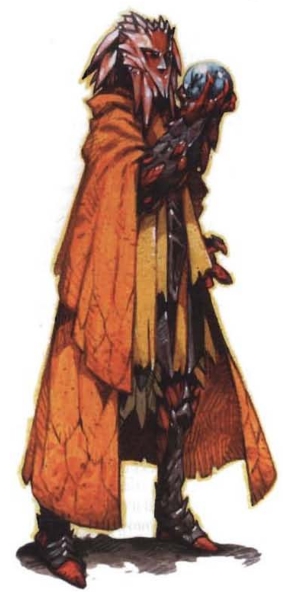
Copyright 2010 Wizards of the Coast. This post is part of a series! Click here to see the others.
Shardminds made their debut as a playable option in the Player’s Handbook 3 for 4e. They’re new to this edition and really lean into its background lore for psionics. They also have the honor of being the second living construct species presented in the game (after Warforged). This entry presents some shardmind stat blocks for use as NPCs or enemies.
The Lore
At the dawn of time there was a crystaline entity named the Living Gate. Neither god nor primordial, the Gate protected the border between the known planes and the Far Realm. It stood firm even during the Dawn War, but it was eventually sundered by the combined efforts of mind flayers, beholders and other Far Realm inhabitants who wanted to enter the world for reasons ranging from the inscrutable to the foul.
Though the Living Gate was shattered and its pieces spread through the cosmos, its will lived on, gifting the disparate shards with life and purpose. These are the shardminds, living constructs with a strong affinity for psionic power and ancestral memories that compel them to rebuild the Living Gate and once again seal the Far Realm away.
Despite that common ancestral memory shardminds as individuals are as varied in outlook and personality as any other sapient species. Over the ages they have formed three major schools of thought that propose different ways of continuing the mission of the Living Gate. The MM3 doesn’t describe all of them, but I will because they’re cool.
The Thought Builders believe the correct solution is to build a new Living Gate and imbue it with the psionic power necessary to seal the Far Realm. Their main goal is to acquire the knowledge necessary to do so. They tend to be Good and worship Ioun.
The God Shards believe that the Shardminds now form a distributed network that carries on the duties of the Living Gate. It’s each individual’s duty to train and nurture their own power so that they can better contribute to this task. Once this network is strong enough, the Far Realm will be sealed. They tend to be Unaligned and worship no gods.
The Shard Slayers are the faction most likely to come into conflict with the PCs. They believe that the original Living Gate can rebuild itself if it’s psionic energy is allowed to return to its original site. However, this energy is “trapped” in the shardminds, and must be forcibly “released”. So yeah, adherents of this philosophy want to kill all other shardminds and then themselves. They are usually Evil and worship Vecna.
The stat blocks in this entry represent Shard Slayers suitable as mid-to-late Heroic opposition. If your group has one or more shardminds, they have a built-in reason to be hostile. Even if it doesn’t, most non-Evil PCs will be interested in stopping a bunch of genocidal maniacs.
The Numbers
Shardminds are Immortal Humanoids with the Living Construct keyword. They have Resist 5 Psychic and a ground speed of 6. Their signature power is the same one PCs get: Shardswarm, an encounter power which allows them to break apart and reform a short distance away. This causes every adjacent enemy to grant combat advantage for a turn and lets the shardmind teleport half their speed.
Shardminds speak Common, Deep Speech, and have telepathy with range 5.
Shardmind Warseeker
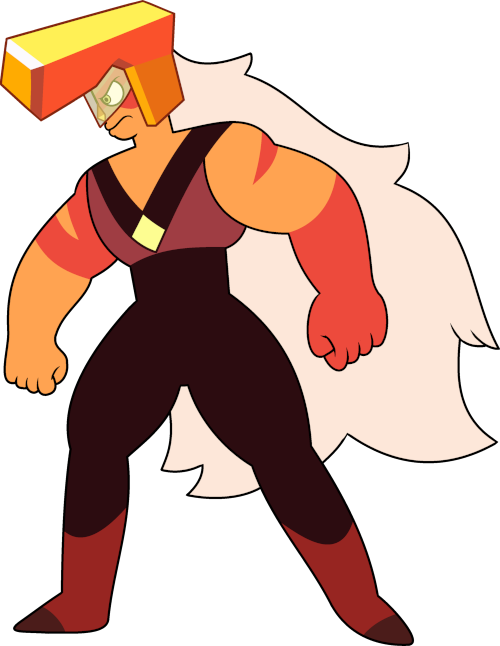
Jasper, from Steven Universe. This psychic warrior disguises its true nature beneath a suit of plate, and wanders about seeking shardminds to slay. Its outwardly calm demeanor hides a murderous rage, which reveals itself when it’s wounded in combat or when an innocent bystander fails to answer its questions.
The warseeker is a Level 6 Soldier with 70 HP. It wears plate and fights with a broadsword and a heavy crossbow. Heavy armor means its speed is only 5.
Both the sword and the crossbow are basic attacks that damage and mark for a turn. If a marked enemy within 5 squares of the warseeker targets makes an attack that doesn’t target it, the warseeker can deal 5 psychic damage to that enemy. Once the warseeker is bloodied, its Furious Mind grants it 10 temporary HP, a -2 penalty to AC, and a +4 bonus to damage for the rest of the fight.
This is a basic frontline fighter with some tricks borrowed from the paladin and the barbarian. It’s sticky and a good choice to form a solid “wall” with other soldiers and brutes.
Shardmind Dominator
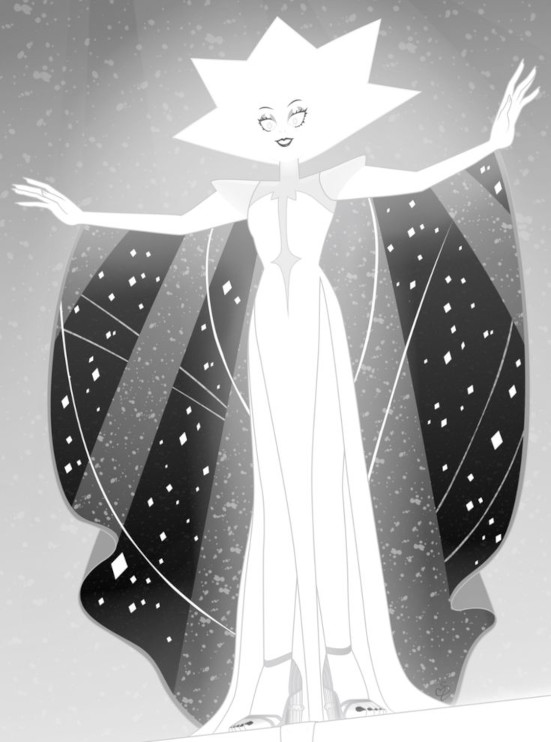
White Diamond, from Steven Universe. A psion who is a big fan of mind control. It’s a Level 8 Controller with 86 HP. It wields a dagger as a basic melee attack, but the important bits are its powers geared towards brute-force mind control.
Overwhelming Mind is an at-will power that only has an “Effect” line, meaning this always happens: it forces an enemy within 5 squares to make a melee or ranged basic attack against a target of the dominator’s choice. If the attack hits, the dominator slides the enemy 3 squares. Psionic Puppet (recharge 5+) is a non-damaging ranged attck that dominates the target on a hit (save ends). And Mind Swarm (encounter) is an area attack that deals psychic damage and creates a zone that lasts the rest of the encounter. Enemies who end their turn inside can be slid 3 squares by the dominator.
Dominators will be doing little damage on their own, but they’ll cause lots of friendly fire incidents and will make it very hard for the party to maintain any sort of coherent formation.
Shardmind Executioner

Bort, from Land of the Lustrous. A skilled assassin dispatched to murder shardminds identified by its buddies. It’s a Level 10 Lurker with 81 HP, wielding a crystal greatsword called a Shardblade. It does standard damage for its level, which can be increased by the Psychic Boost (recharge 5+). This is a free-action power that triggers when the executioner hits with the sword, so it’s never wasted on a missed attack.
The executioner attacks a range with a Mind Shadows power, which deals light psychic damage and blinds the target for a turn. It can also perform a Psychic Infiltration, a melee attack vs. Will. On a hit this removes the executioner from play and causes the target to suffer 20 ongoing psychic damage and be dazed (save ends). When the target saves, the executioner appears adjacent to it. This is an at-will power.
A boosted sword strike actually deals more damage than a round of Infiltration, but the latter is an excellent move to use while Psychic Boost recharges, as it shields the shardmind from damage. So this lurker actually hides inside the enemy’s minds, and deals massive damage while doing so.
Final Impressions
I love all the living constructs, and shardminds are no exception. Their default appearance is a bit meh, but as you can see by the illustrations I chose here this can be easily remedied.
-
Let's Read the 4e Monster Manual 3: Shadow
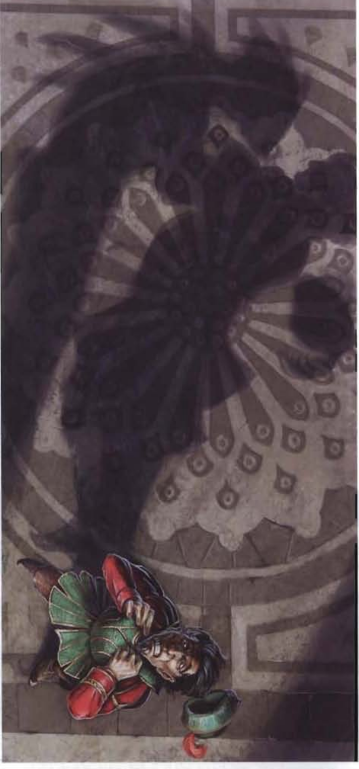
Copyright 2010 Wizards of the Coast. This post is part of a series! Click here to see the other.
Shadows have been in the game since the beginning. They were usually undead in previous editions, but here they get a bit of new lore.
The Lore
It’s understandable that someone would think shadows are undead, but the truth is that they are a species of creature native to the Shadowfell. They’re sapient but they perceive the world in a way that makes then inimical to most other living creatures. They hate light, and believe the shadows cast by living creatures to be prisoners in cages of flesh. Many seek to rescue these prisoners by destroying their cages.
Shadows might form alliances of convenience with other people that would offer them the chance to “liberate” lots of living creatures, but they rarely care for the causes or gods of us fleshlings. The exception seems to be spellcasters versed in shadow magic, who can summon them very easily and always find them to be obsequious and eager servants. It’s almost like the shadows know something that these mortal masters don’t.
Shadows slip into the world via these summonings or at natural contact points between the world and the Shadowfell. Their number has increased in recent years, but no one knows why yet.
The Numbers
Shadows are Medium Shadow Humanoids with a ground speed of 8 and Darkvision. They’re insubstantial but vulnerable to radiant damage. Exposure to ambient light doesn’t damage them, but reveals their position and leaves them with less places to hide.
Their signature trait is Born of Shadows, which allows them to make Stealth checks to hide mid-combat when they have any amount of concealment, instead of needing total concealment. All of the variants here are trained in Stealth.
Shadow Stalker
This one is equivalent to the classic shadows of editions past. It’s a Level 3 Lurker with 25 HP.
The stalker attacks with a shadowy touch that does necrotic damage, and it has a Shadow Stalk power that deals necrotic damage and allows it to meld with an enemy’s shadow (save ends). While melded, the shadow moves in lockstep with its victim, without provoking opportunity attacks. It gains a +4 to all defenses and a +5 to attack the victim. When the victim saves, the shadow appears on an adjacent square.
Its triggered action is Shadow Step: when a nearby creature drops to 0 HP, the stalked teleports to an adjacent square and gains a +2 bonus to attacks for a turn (from eating the victim’s shadow). This also recharges Shadow Stalk.
Shadow Stalkers become major threats if they manage to land their Shadow Stalk attack. Its buddies should focus fire on the stricken PC, which increases the chances of the PC dropping to 0 HP and recharging the power. Note that it’s possible for multiple stalkers to meld with the same PC’s shadow, and that the attack also recharges if an enemy hits 0 HP.
PCs should focus their fire on any shadow stalkers in Team Monster, preferrably with radiant and force attacks to kill them quicker.
Shadow Strangler
This is a spellcaster specializing in remote shadow control. It uses the shadows it devours to fuel its magic, so it must feed more frequently than its fellows. Stranglers are Level 9 Artillery with 53 HP.
The Strangler’s shadowy touch deals necrotic damage and makes invisible to the target for a turn. Its basic ranged attack is a spell namd Blinding Shadows that deals the same amount of necrotic damage and makes the target unable to see further than 3 squares for a turn. Its special attack is Strangling Darkness (recharge 5+) which restrains and deals ongoing 15 damage (save ends). And finally it has an encounter power named Devouring Dark that’s basically a “shadow fireball” that deals light necrotic damage and blinds everyone it hits for a turn.
Despite being artillery, stranglers are very controllery. They pair well with lurkers whose increased damage depends on combat advantage or on being unseen by their targets.
Shadow Puppeteer
This powerful shadow has a more refined palate. It seeks to feed on the shadows cast by souls as they depart for the afterlife. So while the others might leave their victims a bit drained but alive, this one is definitely out for murder.
Puppeteers are Level 14 Lurkers with 74 HP. Their shadowy touch deals extra damage against targets that cannot see it, and creates a zone of lightly obscured squares centered on the target’s space that lasts for a turn. Its special attak is Shadow Puppet, which targets a creature that cannot see the puppeteer, deals light necrotic damage, and dominates them until they start their turn not adjacent to the shadow.
Puppeteers and stranglers have amazing synergy. If you want your PCs to sweat for their victory, it’s definitely worth it to adjust their levels so they’re closer to each other and can be included in the same encounter. Keep the strangler as the lower-level half of the pair to make things slightly less hard for them.
PCs fighting a puppeteer should remain mobile to avoid lingering in the darkness it creates, and should use forced movement powers to keep it away from potential domination targets. If they face the tag team described above, they should focus on killing the strangler first, since it frees the puppeteer from having to set up its lurker bonuses.
Final Impressions
Shadows don’t usually work well with other monsters, so you’re most likely looking at all-shadow teams when building encounters. If you want more variety it might be possible to turn another monster into a shadow by changing its origin, halving its HP, making it insubstantial, and making its basic attack into a touch that targets Reflex and deals necrotic damage.
The original reason shadows were scary was that they drained Strength, but here they’re scary because they’re sticky. The basic stalker can enter your shadow and attack you from there until it kills you. The puppetter does the same but dominates you to attack your friends while it’s doing it. And the strangler makes it a lot easier for the other two to do their part.
-
Let's Read the 4e Monster Manual 3: Secret of Vecna
(The book has an illustrated Secret of Vecna. I did not include the image here because it’s gross.)
This post is part of a series! Click here to see the other.
I first saw a stat block for these in Thunderspire Labyrinth, the second heroic-tier module published for 4e. They appear here in revised form.
The Lore
Vecna is an ascended lich, the evil god of secrets and magic. He teaches that secret knowledge is the path to power, encouraging and rewarding his followers to learn all they can by whatever means necessary. He also punishes his followers for willingly sharing these secrets, an act that is anathema to him. The most common punishment is to transform the heretic into a Secret of Vecna.
These creatures resemble bald humans with plain features, usually wearing robes and wielding daggers or staffs. When they get seriously wounded, their skin sloughs off and they turn into an horrific living ghoul with wickedly sharp fangs and claws. Secrets lack any will of their own, living to do the bidding of their divine patron. They get sent to guard sites important to Vecna, or to aid the plans of his priests. A Secret’s ultimate aim is always to advance Vecna’s goals, though, even to the detriment of his followers. Smart followers know never to trust a Secret completely.
Legend says there is a ritual capable of mending a Secret and turning them back into the person they used to be. This could be done for altruistic reasons, or as a means of getting access to the information that person knows.
The Monsters
Secrets are Medium Natural Humanoids with a speed of 6. They are not undead and have no special resistances.
Their signature ability is Horrific Visage, which triggers as soon as they’re bloodied. It works as a Close Burst 3 attack vs. Will. On a hit it does light psychic damage and pushes the target 3 squares. This is the transformation into a ghoul-like horror.
Some of the monster’s abilities can only be used before it transforms, while others can only be used afterwards. So in practice each Secret has two distinct attack profiles. The human one is usually some degree of tricksy, while the “monster” one is simpler but stronger.
Enigma of Vecna
A spellcaster who grew too greedy and offered to sell or barter the secrets they learned in service to Vecna. They retain some of their magic, and gain the ability to temporarily strip a victim of its memories. They’re Level 6 Controllers with 68 HP.
When human, they fight with daggers and magic. Shock Bolt is a ranged attack that targets Reflex and does lightning damage, also slowing the target for a turn. And Memory Ripper is another ranged attack targetting Will and doing light psychic damage with an awesome rider. Targets hit by this spell are prevented from using encounter or daily attack powers, and any utility powers (save ends).
After the Enigma is bloodied, Horrific Visage triggers and it transforms into a straightforward melee combatant. Its only attack from that point on is Rend Flesh, which does heavy physical damage.
Spell Howler of Vecna
This is a more powerful caster who failed Vecna in some way. Maybe they failed on a mission given to them by the god, or failed to share a secret with Vecna after discovering it. Or maybe they just dug too deep and looked into matters forbidden to one of their rank. They’re Level 18 Artillery with 130 HP.
Spell Howlers are powerful enough to not need weapons. Their basic attack is a Maddening Touch that deals psychic damage. Their basic ranged attack is a Word of Force that targets Fortitude and does force damage. They can use a Word of Madness to deal psychic damage, slide the target 3 squares and have it make a free attack against another target of the howler’s choice. This recharges on a miss, so they can keep trying it. And finally they can say a Word of Pain once per encounter to deal heavy necrotic damage to a target, half on a miss.
Most of this stops after the transformation. Maddening Touch remains an option, but their only ranged attack is now the Word of Doom, which deals psychic damage and dazes for a turn.
Secret of Vecna
The titular monster of the entry used to be a high priest of Vecna who allowed some of the god’s secrets to fall into the hands of a non-believer. Vecna appears to them personally to shatter their minds and transform their bodies.
Secrets are Level 19 Skirmishers with 176 HP. Faster than average, they have a Speed of 8 and a Teleport speed of 4.
In human form, they use a Cloak of Ignorance spell that covers a Close Burst 3, deals psychic damage, and makes them invisible to the target (save ends). Then they move in with Shocking Grasp, a basic attack that deals lightning damage and has a big damage bonus when the target can’t see the monster.
After transforming, their only attack is Thundering Claws, which deals heavy thunder damage, knocks prone, and slides 1 square.
Final Impressions
This is exactly the sort of odd monster that you can typically find in Monster Manuals numbered 3 or above. Fortunately they had enough space for a nicely evocative bit of lore. Their mechanics are an interesting take on the “two-stage” monster, and a different one from both the MM2’s Phoeras and Fey Lingerers.
As the lore mentions, these are Vecna’s specialty divine servitors, so they’ll be found wherever the god’s cultists and temples are.
-
Let's Read the 4e Monster Manual 3: Scarecrow
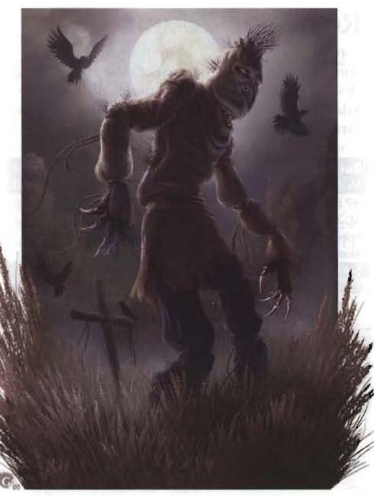
Copyright 2010 Wizards of the Coast. This post is part of a series! Click here to see the other.
The concept of scary animated scarecrows is a classic, so I’m sure they popped up in earlier editions. This is their 4e debut.
The Lore
Scarecrows in the middle world are straw mannequins placed on fields to keep birds away. Scarecrows in the Feywild are terrifying constructs built to keep people away, and to tear them to pieces if they get too close. Both look the same, so never forget which plane you’re in.
The first animated scarecrows were created by a hag with straw stolen from a farmer at the stroke of midnight, clothes from a freshly slain corpse, and thread made from the hair of a nightmare. The idea spread quickly, and now lots of different people use them. I imagine the recipes used by less evil creators are not as macabre, though the construction of a scarecrow still involves a lot of work.
Scarecrows are a bit less sturdy than golems, but they’re much smarter. They can understand more complex instructions and have a link to their master that allows for long-distance, two-way communication. When a scarecrow spots an intruder, it transmits what it sees to its master. They’re alarm and surveillance systems in addition to being guardians.
If the master dies, any surviving scarecrows will keep following their last orders. This means you could find an ancient ruin guarded by masterless scarecrows in the Feywild.
The Numbers
Scarecrows are Medium Fey Animates (Constructs). They’re immune to disease, poison and sleep, though non-minion variants are also vulnerable 10 to fire. They have low-light vision and a speed of 6.
Scarecrow Shambler
A proper scarecrow takes months of careful work, with each stitch and each bit of straw placed precisely in the configuration that will allow it to hold the most magic reinforcement and power. A skilled enough ritual caster, however, can cut a bunch of corners and and produce a small army of these crude models.
Shamblers are not much tougher than a mundane scarecrow, as their magic barely holds them together. They are still strong enough to kill someone with their bare hands, and are filled with toxic mold that spreads through the air when they are destroyed.
These creatures are Level 10 Minion Brutes. Their basic attack is claw that does physical damage with no special riders. When destroyed, they disintegrate in a puff of moldy straw, creating a zone in a Close Burst 1 that lasts until the end of the encounter. The zone is a poison cloud: it’s lightly obscured and deals 10 poison damage to anyone who starts their turn inside.
Clearly, shamblers are meant to die en masse and blanket the battlefield in a giant poison cloud. An ignorant wizard might inadvertently help them along by popping an entire group with an area attack. I guess they still act as cameras for their master too.
Scarecrow Guardian
The “baseline” model discussed in the lore section, painstakingly crafted to act as a guardian. They’re Level 13 Soldiers with 107 HP.
Guardians fight with their Claws, which damage and mark on a hit. They also have a couple of gaze attacks: Luring Gaze (at-will) is a ranged attack that deals psychic damage and pulls the target 5 squares; and Horrid Gaze (minor action, encounter) is a Close Blast 3 that deals no damage and immobilizes for a turn. These are tailored to allow the monster to prevent intruders from escaping.
They’re also deceptively hard to kill - the Malleable Straw interrupt kicks in when they’re damaged, and causes them to take half damage from the attack. Since it’s an interrupt, it only works once per round, but still makes them more durable than their HP would indicate.
Scarecrow Haunter
Haunters are created by adding an extra ingredient to the original scarecrow recipe: the heart of someone who was killed by another scarecrow. It gets sewn into the construct’s body, from which it irradiates the fear its former owner felt before dying. The haunter twists this raw emotion into frightening illusions when hunting down intruders.
Haunters are Level 13 Lurkers with 99 HP. They fight with Claws and have several interesting special attacks. The first one we must mention is the Lurking Horror passive trait. It makes it so all of their attacks deal 5 extra damage and have their forced movement increased by 2 squares.
As lurkers, haunters can begin harrassing the party from a distance, while safely hidden. Haunting Echoes an area burst 2 within 10 attack that targets the Will of all enemies inside. A hit slides the target 2 squares and forces them to make a basic attack against a creature of the haunter’s choice as they try to fight the imaginary ghosts conjured within their minds. With Lurking Horror, this slide could be as large as 4 squares.
Once spotted, they can use Terrifying Gaze (recharge 5+) as a minor action to keep the PCs at bay. This is a Close Blast 3 that targets Will, deals light psychic damage, and pushes 2 squares.
Their “hiding” ability is Fluttering Straw, which allows them to seemingly burst into a cloud of rotten straw and rags while teleporting 6 squares and becoming invisible and insubstantial for a turn. They’ll use it to avoid being surrounded and to resume their stealthy “grenading” with Haunting Echoes.
Final Impressions
Quite interesting! Animated scarecrows are always good for a bit of scary fun, and these don’t disappoint. I like the contrast with golems: the creation of a D&D golem is described like a highly technical process that involves trapping elemental spirits. The creation of a scarecrow is the telling of a scary fairy tale, relying on the inherent narrative power of its ingredients.
Unless you choose to make less evil scarecrow recipes a thing in your setting, they’re probably the domain of hags, lamias and other paragon-tier evil fey. A particularly ancient hag is going to have a small army of Guardians and Haunters protecting her territory, and the realization that each of these represents at least one of her previous victims will add to the horror of the situation.
If you want your Heroic-tier players to meet scarecrows without having to trek to the Feywild, I would suggest statting the Shambler as a Level 3 Regular, and knocking the other two down to level 6 or so.
subscribe via RSS